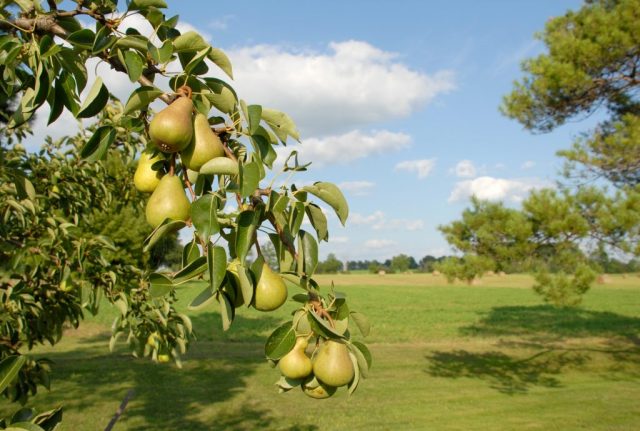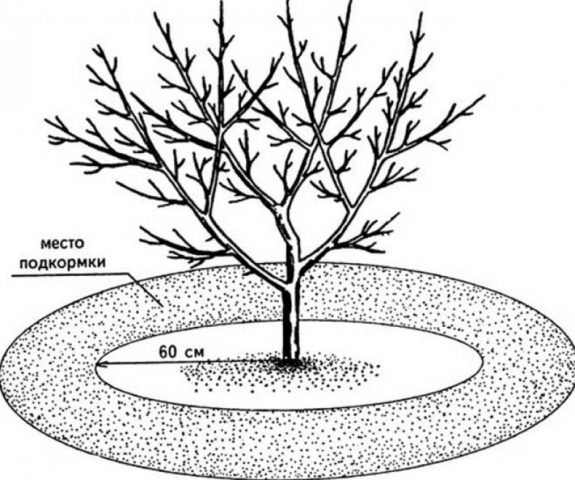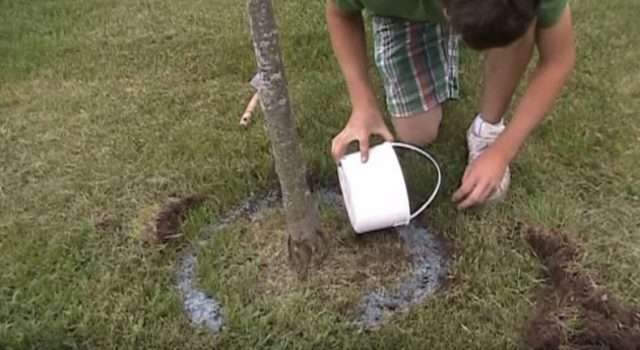Content
To feed pears in spring on time and with appropriate fertilizers is the main task of the gardener. Flowering, the formation of ovaries and their subsequent development depend on the procedure. Summer top dressing promotes fruit flow, and autumn dressing will strengthen the tree before winter trials. It is important to use fertilizers at the rate, while the deficiency will only affect the yield, and the excess sometimes ruins the tree.
Why do you need pear feeding in spring
Pear trees are fed systematically, but fertilizers applied in a timely manner in spring are especially important for plants. They ensure the activation of growth and development of the crown, the growth of new shoots, the quality and quantity of fruits not only in the current year, but also for future harvests. According to the algorithm generally accepted by gardeners, at the beginning of the development of culture in the spring, three dressings are carried out:
- with swelling of the kidneys;
- at the time of blooming buds;
- at the beginning of creating the ovaries.
All preparations for fertilization in spring include nitrogen:
- assimilating nutrients from the first feeding, the pear gives up a significant part of them for the crown and foliage, the growth of new shoots;
- fertilizers after the second feeding stimulate the number of formed flowers, forming the volume of the crop;
- an important third support of the tree with nitrogen-containing fertilizers, which will prevent the ovaries from falling off and give the pear an opportunity to nourish the growing fruits.
Complex preparations, where the composition contains potassium and phosphorus, will contribute to the correct formation of fruits in June. These elements decompose for a long time, and their inclusion in pear fertilization in spring is timely, although they are used by the tree only in summer. Sometimes gardeners take only nitrogen substances for the first two dressings - ammonium nitrate or urea. But for the last fertilization in the spring, preparations with different components are more often used, remembering that the tree will have to feed the set fruits.
Fertilizers for pears
There is a rule: in spring, pears are given two-thirds of the total amount of dressing during the warm season. Along with mineral agents, widely used available organic fertilizers are widely used: bird droppings, mullein, or waste from other herbivores. The remaining volume is used in the summer.
Organic
Often, gardeners bring organic matter under the pear from the very beginning of spring. Over time, humus or compost decomposes and feeds the tree with the substances it needs during this period, especially nitrogen. Chicken droppings are also popular as a third spring feeding, which serves as a source of not only nitrogen, but also rich in various other elements. Organic herbal infusion stimulates vegetation, which is also applied as the last fertilizer in spring. Mullein or bird droppings are added to the green mass during fermentation.
Organic matter, compost, well-rotted humus or even caked manure are often used in the fall for mulching the pear tree trunk circle, which is carried out before the onset of cold weather. In the spring, after digging, the substances nourish the roots of the tree. Humus or bird droppings are applied under the pear after 2-3 years.
Mineral
There are many convenient complex preparations for the garden from the leading companies in this industry - "Fertica", "Super Master", "Actiwin", "Plantafol", where the entire composition is balanced and scientifically calculated. Such fertilizers include not only three macronutrients, nitrogen, potassium and phosphorus, but also many trace elements necessary for plants: manganese, magnesium, boron, copper, iron and others. More popular are the usual tools that are produced by the domestic industry:
- nitroammophoska;
- nitrophoska;
- nitrophos;
- diammofoska;
- ammophos;
- nitroammophos.
Different fertilizers are applied in the spring according to the type of soil. Therefore, it is better to purchase mineral products in local stores, where they are imported in accordance with demand and need.
In spring, pears are fed with ammonium nitrate or carbamide, which also has another name - urea. In summer, boron compounds, potassium salt, potassium monophosphate, superphosphate, magnesium sulfate and others are taken for fertilizers. It is recommended to carry out foliar feeding during this period.
How to fertilize a pear in spring
After the snow has melted, you can already carry out root dressing in the garden. The main condition for successful fertilization in spring or summer is loose and moist soil. Only mature trees or seedlings of the year before last are fed. A young plant of autumn planting does not need feeding, for the entire warm season it has enough of those substances that are placed in the pit.
Fertilizers when planting pears
For such a powerful and high-yielding tree like a pear, it is recommended to prepare a planting pit in advance. If a pear is planted in the southern regions in the fall, the pit is dug in the spring or early summer. For planting pears in the middle lane and in more severe climates, spring is usually chosen, but the pit for the tree is prepared in October. When placing a seedling on fertile soils, fertilizers are also laid. As one of the options, nutrients are not placed in the hole, but enriched with them the future area of the trunk circle during preliminary digging.
The light-loving plant is placed in a spacious place, avoiding windy and low-lying areas. The pear thrives on fertile loams. On other soils, a special planting substrate is introduced into the pit, if necessary, in clay, and a drainage layer is arranged. Dig holes for pears are spacious, up to 70-100 cm in diameter, up to 70-90 cm deep. The composition of the planting substrate for pears varies depending on the soil:
- on soils rich in humus, use an incomplete bucket of compost or rotted humus, 2 tbsp. l. superphosphate and 1 tbsp. l. potassium sulfate;
- a pit on poor soil is filled with a mixture of 3 buckets of humus, 2 buckets of sand or a bucket of clay, guided by which component prevails in the soil, and part of the fertilizer also increases - up to 10 tbsp. l. superphosphate and 2-3 tbsp. l. potassium sulfate;
- on acidic and heavy clay soils, first half a year before planting pears in spring, a solution of 400 g of dolomite flour is added to the site in a bucket of water, pouring out the specified amount per 1 sq. m;
- after 10-30 days, laying a hole, mix the substrate in a ratio of 1 liter of humus to 1 liter of garden soil.
What fertilizer to apply before pear blossoming
In early spring, they manage with nitrogen substances of choice:
- 200 g of urea is poured with a solution in a bucket of water on 2 adult trees, and an apple tree is also possible;
- for the same number of plants, they are bred in 10 liters full, with a slide, 1 tbsp. l. ammonium nitrate;
- 200 g of chicken manure is infused for 20-24 hours in 5 liters of water to fertilize one pear.
Infusions for dressing are poured into grooves along the perimeter of the trunk circle or onto the soil, with mandatory preliminary or subsequent watering. Sprinkle fertilizers in the spring and dry, digging and then watering the earth. If there is constant rainfall, watering is dispensed with.
The beginning of spring, before bud break, is a convenient time to use ferrous sulfate for pears.Spraying the tree will protect against pests and diseases, as well as replenish the iron reserves for the plant.
If this element is missing:
- leaves turn yellow or discolored;
- small annual growth;
- the tops of the shoots are dry;
- the fruits become smaller every year;
- the pear drops its leaves early.
In March, 100 to 500 g of ferrous sulfate are bred in a bucket of water. And if a tree is treated by leaves, only 10-50 g, because greens may be burned.
How to feed a pear during flowering
When the buds bloom, the pear is fed with the same substances as the first time. You can repeat an identical nitrogen fertilizer or take another from the list above. The solution is also distributed along the grooves, followed by abundant watering. Granules do not insist for long, making sure that the mixture does not stand for more than 10-12 hours.
How to feed a pear for growth after flowering
The third top dressing in the spring in the ovary formation phase is carried out with the help of any complex fertilizers, which are recommended by the retail network for horticultural fruit crops. These can be the usual preparations consisting of three elements - phosphorus, potassium and nitrogen. Or modern designs with various additional minerals.
For example, the norm of nitroammofoska for 1 adult tree is up to 150 g. For fertilization, 50 g of the product are diluted in a bucket of water. To fertilize one pear in the spring, you need at least 30 liters of infusion. In addition, the trunk circle is watered. Other complexes for dressing in the spring are used, carefully studying the instructions for the drug.
Now is the right time to create a green fertilizer from young succulent grass and grown weeds:
- the container is half or more filled with cut greens;
- add 1 tbsp. l. urea or humate according to the instructions - as a source of nitrogen, which will accelerate fermentation;
- fill in with water and cover;
- after 10-14 days, with the appearance of a persistent unpleasant odor of ammonia, the grass is taken out with a pitchfork, using it for mulch in the garden or in the garden;
- the liquid is diluted with water 1:10 and poured into 2-3 buckets under the pear, into grooves 8-10 cm deep, which are then buried.
Pear feeding rules
Mineral and organic fertilizers will be beneficial if applied correctly in spring and summer:
- nitrogen preparations are not taken for planting;
- root dressing is applied by digging the trunk circle to a depth of 10 cm;
- use strictly recommended doses of funds without increasing;
- it is advisable not to mix more than two monofertilizers on your own; if necessary, it is better to buy balanced complexes.
After root and even foliar feeding, the pear is watered.
Foliar feeding of pears in summer
In June, then after 20 days, in July, pears are sprayed with fertilizers for good fruit ripening. Foliar dressings work faster than those that are applied to the ground. Substances are immediately absorbed by the leaves and enter the vessels of the tree:
- in the second or third decade of June, the tree is sprayed with a urea solution, as in the spring, to support it with the growth of fruits;
- until July 10-15, feeding is carried out with a solution of 5 g of potassium sulfate in 1 liter of water after 2 weeks - with a solution of superphosphate (30 g / l), according to the instructions;
- spring and summer are the time for foliar feeding of pears with magnesium with 200 g of magnesium sulfate dissolved in a bucket of water.
Gardeners' recommendations
Every amateur gardener has his own little secrets of how, when and how to feed pears:
- for feeding pears in August, they are added dropwise to 1 sq. m along the perimeter of the trunk circle 1 st. l. superphosphate and potassium sulfate, which is also called potassium sulfate;
- to prevent a lack of calcium, in the fall, 150 g of wood ash per 1 sq. m;
- EO preparations are actively used in gardens: humates, Baikal EM-1 and the like;
- in early spring, before the buds bloom, trees are treated with a solution of 20 g of boric acid per bucket of water to preserve future ovaries;
- young non-bearing trees are fed in the spring with nitrogen preparations, and in the fall with phosphorus-potassium complexes.
Conclusion
Feeding pears in spring, summer and autumn means creating a solid foundation for a bountiful harvest. Means with nitrogen will help the tree to develop, potassium and phosphorus - to form beautiful and healthy fruits. Timely application of the recommended doses of fertilizers will support the tree and will not negatively affect the nutritional properties of the fruit.












